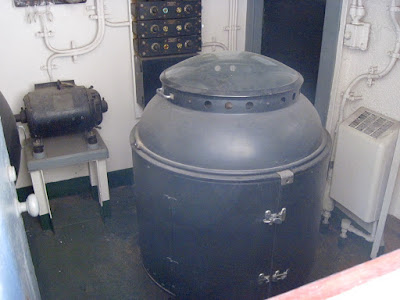She was built during WWII and served during WWII, Korea, and Vietnam. In 1999 she was towed 1,200 miles, from Virginia to Tampa, to be a tour ship. But she’s unusual because she is a “living” ship, capable of getting underway - when they have enough money to fund the project. In 2003 she sailed from Tampa to the Gulf of Mexico, and currently they try to do two voyages a year in Tampa Bay.
One thing needed for a moving ship is lifeboats. Some of the display lifeboats are pretty awful,
but there are some good ones in the davits, ready to go.
So the first thing I learned is that the crane that hold lifeboats is called a davit! And I learned that during the war, lifeboat supplies included a radio. Sailors would raise its antenna, hang a wire into the water to ground it, hand-crank it and tap out morse code. Not easy, but if you needed it, you would be very, very grateful to have it.
To get to the boat, they would sling this wood-and-chain ladder overboard.
Today there were very few tourists on-board, but there was a big contingent of firefighters. They were doing training exercises today. In this heat. Well, that makes sense because when they have to do the real thing, it will be plenty hot.
They were getting into gear inside the ship, then going outside to climb the rigging. Some guys were a little more comfortable than others.
And after they climbed up, they had to come down, rappelling.
It was fascinating to watch them, even in the heat, but we wanted to see the rest of the ship. I love ship gadgets!
The ship's 5-inch stern gun and two 3-inch deck guns are still in place.
And they have a Gyro Compass on-board. This thing was used because ships' magnetic fields could affect regular compasses. According to the display notice: "The Gyro Compass would indicate (almost) true north, so it could be used to steer. It operates on the same principle as a child's gyro, a rapidly spinning wheel which tends to continue to rotate in the same plane when it started". I like the honesty that makes them say "almost"!
The kitchen here is small (for a ship) but effective.
But crew quarters are a little more spacious than on other ships. There are just four bunks in a room, and a locker for each one.
I learned that bathrooms on ships are called “the head” because in the old seafaring days, guys went to the front of the ship (i.e. the head of it) and leaned over to do their business. Eww, but at least everything went overboard.
The engine room is in a lower deck and mostly off-limits. All we can do is look down on it but since this is a working ship, that probably makes sense.
As we got ready to leave, we stopped in the gift shop. This place has the smallest, lowest-stocked gift shop we've ever been in!
Across the bay we saw signs of ship work similar to was is done in Brownsville Port.
And outside was a much newer ship; we wished we could just walk on and sail away!
It didn't take too long to go through the ship so we had plenty of time to go to Cold Stone Creamery and cool down with ice cream, then to stroll through Ikea, planning for our future home.
















No comments:
Post a Comment